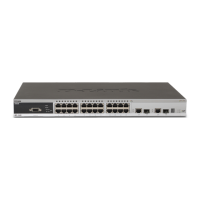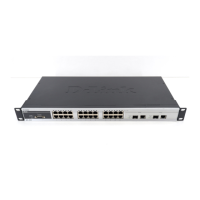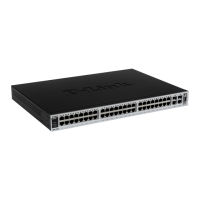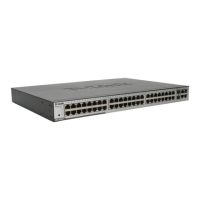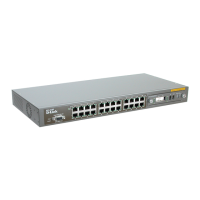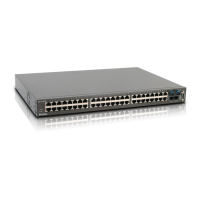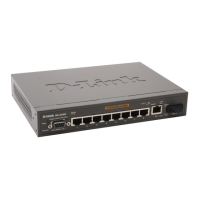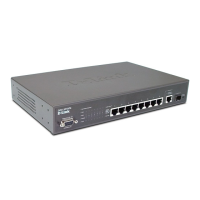Do you have a question about the D-Link DES-3526 and is the answer not in the manual?
General precautions to reduce risk of injury, shock, fire, and damage.
Specific safety guidelines for installing equipment in racks.
Details the DES-3526's ports and capabilities.
Lists the technical features and standards supported by the Switch.
Describes the types and functions of the Switch's ports.
Explains the meaning of various LED indicators on the Switch.
Describes the components on the rear panel of the Switch.
Provides guidelines for optimal Switch installation site selection.
Guidance on mounting the Switch into a standard 19" rack.
Instructions for connecting DC power to the DES-3526DC model.
How to connect PCs, printers, and routers to the Switch.
Connecting the Switch to the network backbone or servers.
How to connect to the Switch's console port for management.
Steps for initial connection and login to the Switch console.
How to set up user accounts and passwords for security.
Steps for assigning an IP address to the Switch.
Overview of the Switch's embedded web-based management interface.
Instructions for accessing the Switch via its web manager.
Description of the layout and areas of the web interface.
How to configure the Switch's IP address via web or console.
Access to general configuration settings for various functions.
Information for configuring individual port attributes like speed and flow control.
Combining multiple ports to create a single high-bandwidth link.
Introduction to Spanning Tree Protocol versions supported by the Switch.
Information on Virtual Local Area Networks (VLANs).
Quality of Service settings, focusing on 802.1p priority queuing.
Limiting traffic flow between ports within a switch or stack.
Locking ports to specific MAC addresses to enhance security.
Establishing criteria for packet forwarding based on header information.
Configuring IP addresses permitted for remote management access.
Managing user accounts and their privilege levels.
Configuring authentication methods like TACACS, RADIUS, and local.
Security feature providing secure communication via authentication and encryption.
Program for secure remote login and network services.
Overview of SNMP management capabilities and settings.
Displays the percentage of bandwidth used on each port.
Displays the percentage of CPU usage on the Switch.
Viewing port error statistics, including received and transmitted errors.
Viewing the Switch's dynamic MAC address forwarding table.
Viewing the Switch's event log for system activities.
Monitoring 802.1x statistics on a per-port basis.
Viewing and searching current ARP entries on the Switch.
Using Trivial File Transfer Protocol for firmware and configuration management.
Saving configuration changes to NV-RAM to make them persistent.
Options for resetting the Switch to factory defaults.
Concept and advantages of managing switches over Ethernet using a single IP.
Enabling and configuring Single IP Management via the web interface.
Visual representation of device connections within a Single IP Management Group.
Details physical dimensions, weight, operating conditions, and safety.
Describes performance metrics like transmission method and packet buffer.
Shows pin assignments for standard RJ-45 ports (MDI-X and MDI-II).
Warranty terms for hardware defects in workmanship and materials.
Limits D-LINK's liability for damages related to the product.
General precautions to reduce risk of injury, shock, fire, and damage.
Specific safety guidelines for installing equipment in racks.
Details the DES-3526's ports and capabilities.
Lists the technical features and standards supported by the Switch.
Describes the types and functions of the Switch's ports.
Explains the meaning of various LED indicators on the Switch.
Describes the components on the rear panel of the Switch.
Provides guidelines for optimal Switch installation site selection.
Guidance on mounting the Switch into a standard 19" rack.
Instructions for connecting DC power to the DES-3526DC model.
How to connect PCs, printers, and routers to the Switch.
Connecting the Switch to the network backbone or servers.
How to connect to the Switch's console port for management.
Steps for initial connection and login to the Switch console.
How to set up user accounts and passwords for security.
Steps for assigning an IP address to the Switch.
Overview of the Switch's embedded web-based management interface.
Instructions for accessing the Switch via its web manager.
Description of the layout and areas of the web interface.
How to configure the Switch's IP address via web or console.
Access to general configuration settings for various functions.
Information for configuring individual port attributes like speed and flow control.
Combining multiple ports to create a single high-bandwidth link.
Introduction to Spanning Tree Protocol versions supported by the Switch.
Information on Virtual Local Area Networks (VLANs).
Quality of Service settings, focusing on 802.1p priority queuing.
Limiting traffic flow between ports within a switch or stack.
Locking ports to specific MAC addresses to enhance security.
Establishing criteria for packet forwarding based on header information.
Configuring IP addresses permitted for remote management access.
Managing user accounts and their privilege levels.
Configuring authentication methods like TACACS, RADIUS, and local.
Security feature providing secure communication via authentication and encryption.
Program for secure remote login and network services.
Overview of SNMP management capabilities and settings.
Displays the percentage of bandwidth used on each port.
Displays the percentage of CPU usage on the Switch.
Viewing port error statistics, including received and transmitted errors.
Viewing the Switch's dynamic MAC address forwarding table.
Viewing the Switch's event log for system activities.
Monitoring 802.1x statistics on a per-port basis.
Viewing and searching current ARP entries on the Switch.
Using Trivial File Transfer Protocol for firmware and configuration management.
Saving configuration changes to NV-RAM to make them persistent.
Options for resetting the Switch to factory defaults.
Concept and advantages of managing switches over Ethernet using a single IP.
Enabling and configuring Single IP Management via the web interface.
Visual representation of device connections within a Single IP Management Group.
Details physical dimensions, weight, operating conditions, and safety.
Describes performance metrics like transmission method and packet buffer.
Shows pin assignments for standard RJ-45 ports (MDI-X and MDI-II).
Warranty terms for hardware defects in workmanship and materials.
Limits D-LINK's liability for damages related to the product.


